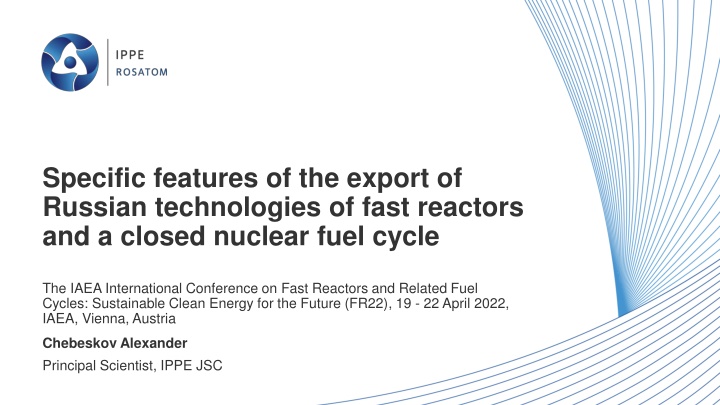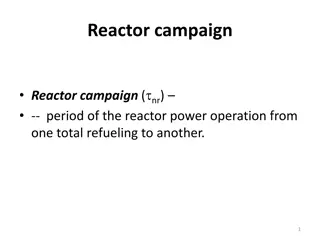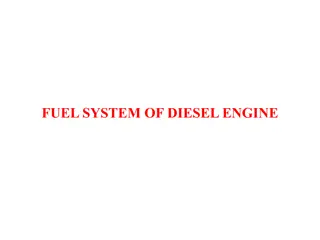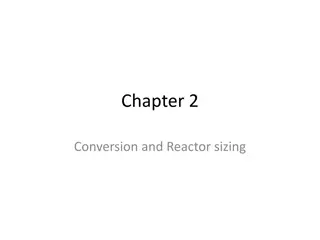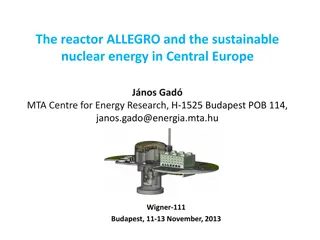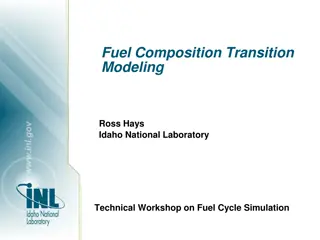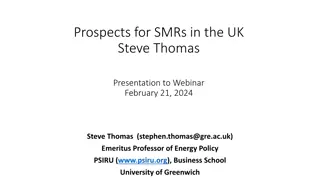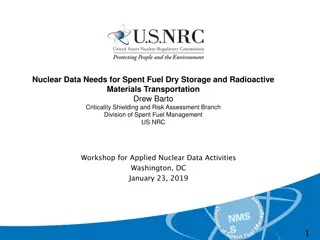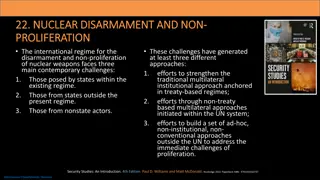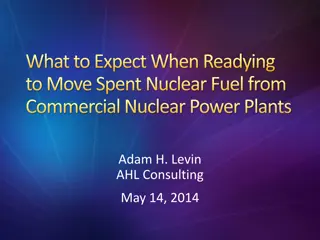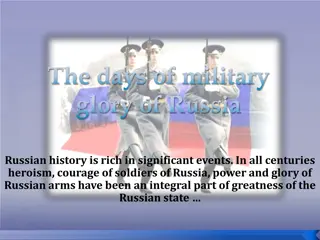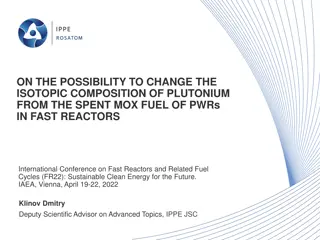Russian Technologies of Fast Reactors and Nuclear Fuel Cycle Export
Russia leads in nuclear power units abroad with ROSATOM's portfolio. The country excels in fast reactor technology like BN series and Proryv project, aiming for sustainable energy and closed fuel cycles. Legal documents ensure nuclear non-proliferation.
Download Presentation

Please find below an Image/Link to download the presentation.
The content on the website is provided AS IS for your information and personal use only. It may not be sold, licensed, or shared on other websites without obtaining consent from the author.If you encounter any issues during the download, it is possible that the publisher has removed the file from their server.
You are allowed to download the files provided on this website for personal or commercial use, subject to the condition that they are used lawfully. All files are the property of their respective owners.
The content on the website is provided AS IS for your information and personal use only. It may not be sold, licensed, or shared on other websites without obtaining consent from the author.
E N D
Presentation Transcript
Specific features of the export of Russian technologies of fast reactors and a closed nuclear fuel cycle The IAEA International Conference on Fast Reactors and Related Fuel Cycles: Sustainable Clean Energy for the Future (FR22), 19 - 22 April 2022, IAEA, Vienna, Austria Chebeskov Alexander Principal Scientist, IPPE JSC
Introduction At present, Russia is the recognized world leader in terms of the number of nuclear power units being built abroad The foreign business portfolio of ROSATOM includes 35 power units in 12 countries A range of services, including construction, operation and maintenance of nuclear power plants throughout the entire life cycle, providing with fresh fuel and, return spent nuclear fuel (SNF) The growing demand for energy, especially in developing countries, problems associated with the limited reserves of natural uranium, the increasing rates of accumulation of SNF from thermal reactors Consensus on the leading role of fast reactors in the future large-scale nuclear power 2
Fast reactors To date, the maturity of the sodium-cooled fast reactor technology has been demonstrated at the industrial level: BN-350 (1972-1999), BN-600 (since 1980) and BN-800 (since 2016) The finalization of the BN-1200 reactor design, related mainly to its economic parameters, almost completed, the BN-1200 parameters is close for the VVER-1200 thermal reactor The Proryv project is developing fast lead-cooled BREST reactors with on-site deployment of a closed nuclear fuel cycle infrastructure For the demonstration, it is planned to build a power unit with a pilot demonstration reactor BREST-OD-300 at the Seversk NPP in the SCC as part of the ODEK An additional direction can be considered the development of a modular SVBR reactor for small-scale power generation 3
Basic International legal documents to ensure nuclear non-proliferation Treaty on the Non-Proliferation of Nuclear Weapons International Atomic Energy Agency safeguards Additional protocol Nuclear Suppliers Group Guidelines Zangger Committee Guidelines Plutonium Management Guidelines Physical protection recommendations 4
Features of fast neutron reactors Fast reactor fuel: safeguards and physical protection, plutonium fuel should be given more attention than uranium fuel for thermal reactors Coolants used in fast reactors: liquid metal coolants are opaque for the visible spectrum of light rays Design features of fast reactors: the core in a fast reactor can be surrounded by a radial blanket with fertile material Fast Reactor Refueling Procedure: all basic operations of refuelling are invisible to the operator, as compared to light water reactors Closed nuclear fuel cycle of fast reactors: the destiny of SNF is connected with reactors in contrast of light water reactors 5
Safeguards system at the experimental fast breeder reactor "Monju" The Monju is a relatively large and fairly modern fast reactor of 280 MW(e) with a sodium coolant, MOX fuel, and radial blanket. The safeguards approach for the Monju was developed in accordance with IAEA document INFCIRC/153, a typical comprehensive safeguards agreement concluded between Japan and the IAEA. It was the first fast neutron reactor in the world to implement the modern Safeguard by Design concept (SbD). The safeguards approach for Monju includes: Determination of material balance areas (MBA) for nuclear material accountancy; Determination of key measurement points (KMP) to measure the flow and inventory of nuclear material; Define strategic positions for containment and surveillance (C/S) and other verification measures; Nuclear material accountancy through analysis of operational records and State reports; Annual Physical Inventory Verification (PIV) - usually during reactor shutdown for refueling (every 6 months); Verification of internal and external transfers of nuclear material; Statistical Nuclear Material BalanceAssessment to determine material unaccounted for (MUF); Routine (monthly) interim inventory verification to detect in a timely manner possible diversion of NM; Verification of information on the design of the facility; Checking the operator's measuring system. 6
Additional safeguards measures for exported fast reactors To develop new methods of non-destructive assay (NDA) to more accurately measure the content of plutonium and actinides in fresh assemblies with transuranium fuel (TRU fuel) received at NPPs with and in spent assemblies sent out from NPPs; Many of these NDA methods or systems will need to be developed to track in-line all movements of fresh and spent fuel. These methods should allow for remote transmission of data in order to remotely monitor the object to provide more effective safeguards; Use of automated, unattended remote monitoring systems is needed to collect data on the safeguards at the facility, cooperating with the facility owner / operator and national authorities to handle proprietary information; Cooperate closely with the facility owner / operator and national authorities to try to incorporate safeguards and safeguards equipment requirements into the concept design at the earliest stages of the facility conceptual design; Make the inspection regime more efficient by using unplanned short notice inspections, applying a statistical process control approach to verifying reprocessing plants, rather than routinely systematically verifying all major transfers of plutonium-containing materials. 7
Concluding remarks Currently, there are two fast power reactors BN-600 and BN-800 being operated in Russia. In this regard, there may be in the future a real possibility of exporting Russian fast reactors to countries that do not possess such technology. For the first time, this topic was proposed for discussion at the International IAEA conference FR13, then the discussion was continued at the FR17 conference. Somewhat later, statements by the leadership of the State Atomic Energy Corporation ROSATOM followed that Russian technologies of fast reactors and closed nuclear fuel cycle could enter international markets in 10-15 years as an export product of the Russian nuclear power industry. All this determines today the need to analyze the potential export of fast reactors, including nuclear fuel, as well as closed nuclear fuel cycle facilities, taking into account both the technical and economic indicators of such power units, and the existing system of International supply regime in the field of nuclear energy technologies. 8
Thank you for your attention ChebeskovAlexander Principal Scientist, IPPE JSC Tel: +7 (484) 399 84 13 E-mail: chebes@ippe.ru 2022
